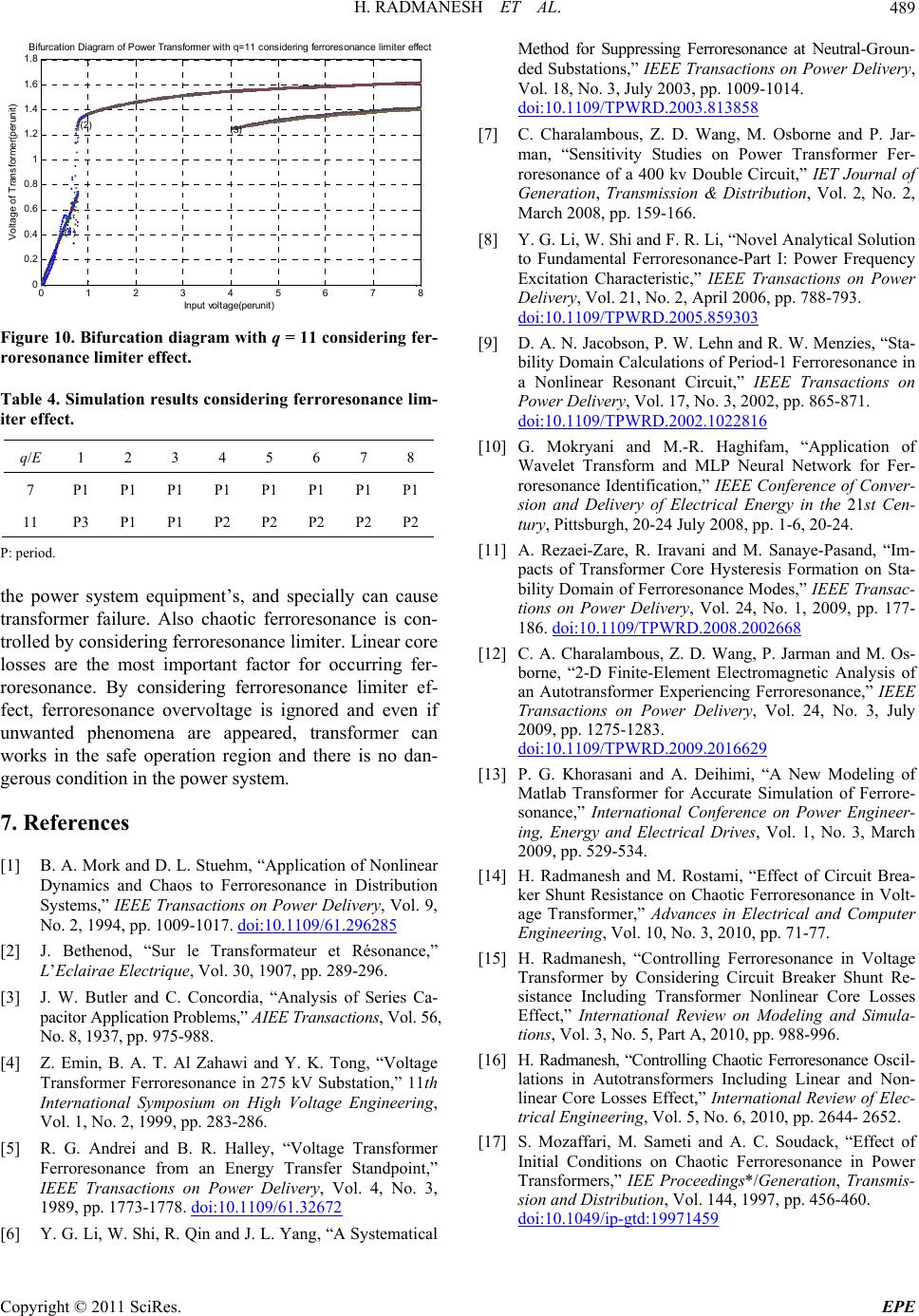
H. RADMANESH ET AL.
Copyright © 2011 SciRes. EPE
489
012345678
0
0.2
0.4
0.6
0.8
1
1.2
1.4
1.6
1.8
Input voltage(perunit)
Voltage of Transformer(perunit)
Bifurcation Diagram of Power Transformer with q=11 considering ferroresonance limiter effect
(1)
(2)
(3)
Figure 10. Bifurcation diagram with q = 11 considering fer-
roresonance limiter effect.
Table 4. Simulation results considering ferroresonance lim-
iter effect.
q/E 1 2 3 4 5 6 7 8
7 P1 P1 P1 P1 P1 P1 P1 P1
11 P3 P1 P1 P2 P2 P2 P2 P2
P: period.
the power system equipment’s, and specially can cause
transformer failure. Also chaotic ferroresonance is con-
trolled by considering ferroresonance limiter. Linear core
losses are the most important factor for occurring fer-
roresonance. By considering ferroresonance limiter ef-
fect, ferroresonance overvoltage is ignored and even if
unwanted phenomena are appeared, transformer can
works in the safe operation region and there is no dan-
gerous condition in the power system.
7. References
[1] B. A. Mork and D. L. Stuehm, “Application of Nonlinear
Dynamics and Chaos to Ferroresonance in Distribution
Systems,” IEEE Transactions on Power Delivery, Vol. 9,
No. 2, 1994, pp. 1009-1017. doi:10.1109/61.296285
[2] J. Bethenod, “Sur le Transformateur et Résonance,”
L’Eclairae Electrique, Vol. 30, 1907, pp. 289-296.
[3] J. W. Butler and C. Concordia, “Analysis of Series Ca-
pacitor Application Problems,” AIEE Transactions, Vol. 56,
No. 8, 1937, pp. 975-988.
[4] Z. Emin, B. A. T. Al Zahawi and Y. K. Tong, “Voltage
Transformer Ferroresonance in 275 kV Substation,” 11th
International Symposium on High Voltage Engineering,
Vol. 1, No. 2, 1999, pp. 283-286.
[5] R. G. Andrei and B. R. Halley, “Voltage Transformer
Ferroresonance from an Energy Transfer Standpoint,”
IEEE Transactions on Power Delivery, Vol. 4, No. 3,
1989, pp. 1773-1778. doi:10.1109/61.32672
[6] Y. G. Li, W. Shi, R. Qin and J. L. Yang, “A Systematical
Method for Suppressing Ferroresonance at Neutral-Groun-
ded Substations,” IEEE Transactions on Power Delivery,
Vol. 18, No. 3, July 2003, pp. 1009-1014.
doi:10.1109/TPWRD.2003.813858
[7] C. Charalambous, Z. D. Wang, M. Osborne and P. Jar-
man, “Sensitivity Studies on Power Transformer Fer-
roresonance of a 400 kv Double Circuit,” IET Journal of
Generation, Transmission & Distribution, Vol. 2, No. 2,
March 2008, pp. 159-166.
[8] Y. G. Li, W. Shi and F. R. Li, “Novel Analytical Solution
to Fundamental Ferroresonance-Part I: Power Frequency
Excitation Characteristic,” IEEE Transactions on Power
Delivery, Vol. 21, No. 2, April 2006, pp. 788-793.
doi:10.1109/TPWRD.2005.859303
[9] D. A. N. Jacobson, P. W. Lehn and R. W. Menzies, “Sta-
bility Domain Calculations of Period-1 Ferroresonance in
a Nonlinear Resonant Circuit,” IEEE Transactions on
Power Delivery, Vol. 17, No. 3, 2002, pp. 865-871.
doi:10.1109/TPWRD.2002.1022816
[10] G. Mokryani and M.-R. Haghifam, “Application of
Wavelet Transform and MLP Neural Network for Fer-
roresonance Identification,” IEEE Conference of Conver-
sion and Delivery of Electrical Energy in the 21st Cen-
tury, Pittsburgh, 20-24 July 2008, pp. 1-6, 20-24.
[11] A. Rezaei-Zare, R. Iravani and M. Sanaye-Pasand, “Im-
pacts of Transformer Core Hysteresis Formation on Sta-
bility Domain of Ferroresonance Modes,” IEEE Transac-
tions on Power Delivery, Vol. 24, No. 1, 2009, pp. 177-
186. doi:10.1109/TPWRD.2008.2002668
[12] C. A. Charalambous, Z. D. Wang, P. Jarman and M. Os-
borne, “2-D Finite-Element Electromagnetic Analysis of
an Autotransformer Experiencing Ferroresonance,” IEEE
Transactions on Power Delivery, Vol. 24, No. 3, July
2009, pp. 1275-1283.
doi:10.1109/TPWRD.2009.2016629
[13] P. G. Khorasani and A. Deihimi, “A New Modeling of
Matlab Transformer for Accurate Simulation of Ferrore-
sonance,” International Conference on Power Engineer-
ing, Energy and Electrical Drives, Vol. 1, No. 3, March
2009, pp. 529-534.
[14] H. Radmanesh and M. Rostami, “Effect of Circuit Brea-
ker Shunt Resistance on Chaotic Ferroresonance in Volt-
age Transformer,” Advances in Electrical and Computer
Engineering, Vol. 10, No. 3, 2010, pp. 71-77.
[15] H. Radmanesh, “Controlling Ferroresonance in Voltage
Transformer by Considering Circuit Breaker Shunt Re-
sistance Including Transformer Nonlinear Core Losses
Effect,” International Review on Modeling and Simula-
tions, Vol. 3, No. 5, Part A, 2010, pp. 988-996.
[16] H. Radmanesh, “Controlling Chaotic Ferroresonance Oscil-
lations in Autotransformers Including Linear and Non-
linear Core Losses Effect,” International Review of Elec-
trical Engineering, Vol. 5, No. 6, 2010, pp. 2644- 2652.
[17] S. Mozaffari, M. Sameti and A. C. Soudack, “Effect of
Initial Conditions on Chaotic Ferroresonance in Power
Transformers,” IEE Proceedings*/Generation, Transmis-
sion and Distribution, Vol. 144, 1997, pp. 456-460.
doi:10.1049/ip-gtd:19971459